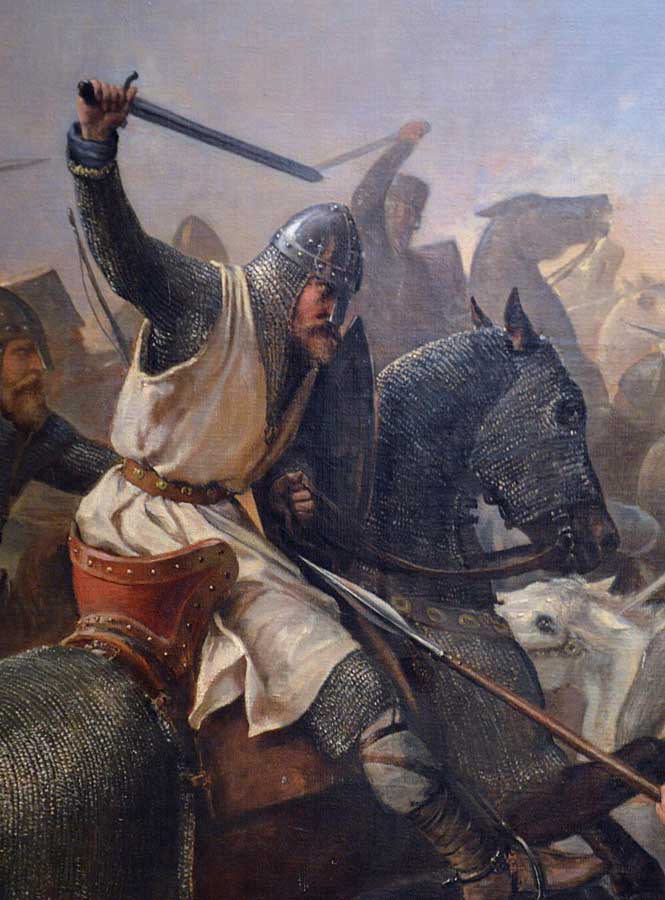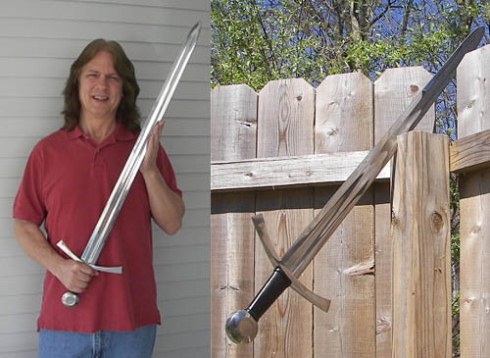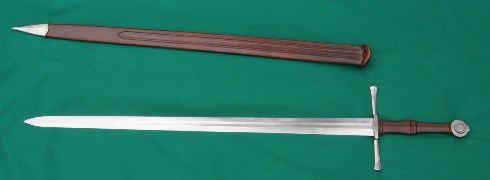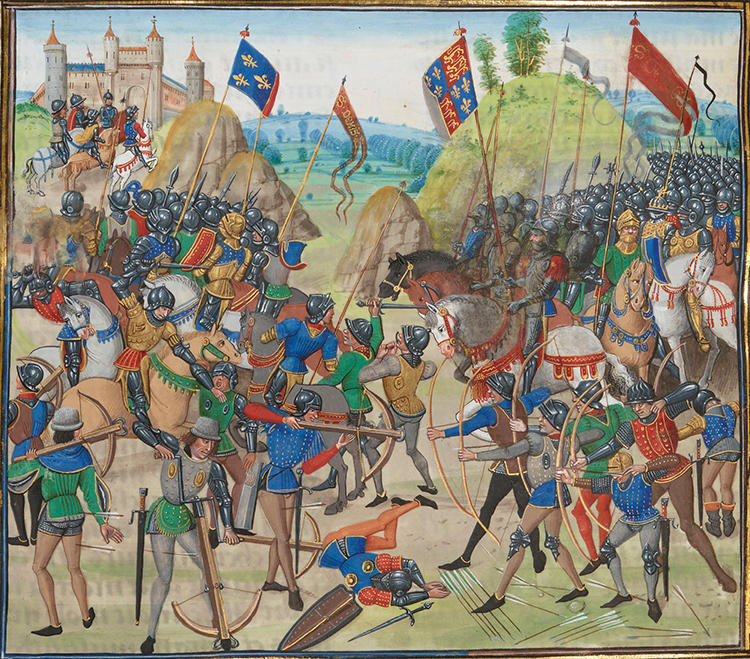Recent Articles
-
July Issue of the Digest Out Now
Jul 01, 25 01:22 AM
The 5 Medieval Sword Types That Changed the Course of History

Even if you can't be bothered to learn the whole of the Oakeshott Typology of swords, there are 5 sword types that every enthusiast of medieval swords NEEDS to know..
There are over 24 medieval sword types in the typology of the foremost scholar of medieval swords, Ewart Oakeshott. Many are quite specialized swords, others only made a brief appearance in the history of the medieval sword. And quite a few are hard to define and pin down..
All of this is pretty intimidating to the beginner. Indeed, it is physically impossible to remember two dozen different sword types in a single sitting - and the only way you will get to know all the types off the top of your head is if you study them one at a time.
* The Pareto Principle: law of the vital few. In our case, it would mean that 20% of the swords in the typology represent 80% of the swords that were in use over the period.
But what if you wanted to shortcut the process?
If we consider the Pareto Principle* - the so called 80/20 rule - it applies here as much as it does anywhere else. Out of the 24 swords, there are basically 5 that really stand out, representing major turning points in the history of the development of the European sword in the medieval period.
This is probably the best way to immerse yourself in the typology - and learning 5 sword types in a single sitting or two is quite doable, right? So without any further ado we present them in the order they appeared in the 500 years from the 10th to the 15th centuries that we call the medieval period, the 5 most important swords from the Oakeshott typology that you should get to know first.
RELATED ARTICLE: Oakeshott Typology Made Easy!
If you want to delve in deep and get the big picture of ALL the major medieval sword types, check out article where we attempt to make a rather complex sword classification system easily digestible.
The 5 Most Important Medieval Sword Types

Oakeshott Type X
The Early Medieval/Late Viking Era Arming Sword
9th - 12th centuries AD

Out of all the medieval sword types, Type X spanned the longest period in medieval history (from the 9th to the 12th centuries) - and was a sword that was used by late period Vikings, the Normans, Crusaders, Anglo Saxons, Templars and Knights alike..
Designed to be used in one hand, either on foot or from horseback, while it could thrust its primary purpose was to cut, and was usually used in conjunction with a shield, helmet and possibly a maille hauberk that would at least deflect some of the damage, but was hardly invulnerable.
In many respects, it shares a lot of characteristics of earlier Viking and transitional medieval sword types. The blade was usually between 31-33" in length, with a wide blade and hollowed out in the middle to lighten and balance it with what is called a fuller (sometimes mistakenly referred to as 'blood groove') and typically weighed between 2-3lbs.
In the late 12th century, during the meteoric rise and central importance of the mounted medieval knight became a central factor to victory on the battlefield, the Type X slowly stated to lose favor as it was becoming ineffective against plate armor that was becoming more commonly used for protection - a medieval arms race if you will. And so it went through several changes, and eventually settled on a new form, which we will examine next..
Click here to learn more about Type X swords and see examples of modern fully functional replicas.
Oakeshott Type XII
Classical Knightly Arming Sword
13th to 14th Centuries AD

In the mid to late 12th century, the medieval sword - which had remained largely unchanged for several hundred years, became the subject of many new innovations and experimental designs. The fuller of the Classic transitional Viking/Early Medieval Sword became narrower, and the blades longer, to be used by the rising Knightly class who were becoming the deciding factor of winning battles during this period.
Believed to have been first developed in the 11th century, it came to prominence in the 13th and 14th centuries, overlapping with the Type X, and together these two medieval sword types represented 80% of the knightly arming swords in use from the early to the high medieval eras.
From horseback or on foot, used with a shield these swords were highly effective, fast in the hand, well balanced and the epitome of the medieval knightly arming sword.
Click here to learn more about Type XII swords and see examples of modern fully functional replicas.
Oakeshott Type XIIa
Classical Knightly Great Sword of War
13th to 14th Centuries AD

If the Type XII is an archetypal medieval knightly arming sword, then the sub type XIIa is the archetypal two handed medieval knightly sword..
Known as Great Swords of War, these huge swords had the same basic profile as the parent group but on a much larger scale - typically around 4' from pommel to tip.
While at first glance they look heavy and un weildly, the total weight was typically between 3-4lbs, and could be used with one hand from horseback, using the momentum of the horse to deliver horrific damage, or gripped with two hands when on foot or dismounted.
Click here to learn more about Type XIIa swords and see examples of modern fully functional replicas.
Oakeshott Type XVa
Classical Longsword/Bastard Sword
14th to 15th Centuries AD

Call them a longsword or a bastard sword, the Oakeshott Type XVa came onto the scene and became more important as plate armor became more common in the 14th and especially by the 15th century.
After all, what can a cutting sword do against a knight armored like THIS?

The short answer is of course, very little..
To be able to injure a knight thus armored, new medieval sword types were developed dedicated to thrusting a reinforced, needle like tip into the gaps and weak points - and one of the most effective was the Type XVa Longsword.
Sometimes used with the off hand gripping the actual blade and jabbing it forward like a spear, these swords were specialized in the thrust - but were no slouch in cutting either, especially when used against unarmored opponents in a judicial or personal duel.
These are also the Longswords most commonly seen in the Fechtbuchs of medieval sword masters such as Johannes Liechtenauer and Fiore dei Liberti , and the sword most popular with students of the Historical European Martial Arts (HEMA).
Click here to learn more about Type XVa swords and see examples of modern fully functional replicas.
Oakeshott Type XVIII
Twilight of the Medieval Sword
Mid to Late 15th Century AD
 The Battle of Crecy
The Battle of CrecyThe Battle of Crecy in the mid 14th century was a foreshadowing of things to come on the medieval battlefield. The increased use of missile weapons such as longbows and crossbows only became more intense in the 15th century, as was the use of Cannons and the long gun known as the arquebus..
Standing armies started to become central to battle tactics, and as a result, the medieval knights central role in warfare began to erode.
This was the twilight of the medieval sword, and as armor became less common on the battlefield in favor of missile weapons, the cutting sword became important again, but instead of going back to the weapons of the past - a new and final type of medieval sword was developed, the Oakeshott Type XVIII.

Combining the best features of cutting swords from the previous centuries with the thrusting capability of later period swords so that when heavy armor was encountered, the knight at least stood a chance of causing some actual damage, they were defined by the diamond cross section and reinforced tip.
Swords that followed from the XVIII became less utilitarian and more geared towards personal defense and even as fashion statements as the medieval era shifted inexorably into the early Renaissance, and these swords represent the last hurrah of the medieval sword before it disappeared into the annals of history..
Click here learn more about Type XVIII swords and see examples of modern fully functional replicas.
Conclusion
While there are many other medieval sword types that are important to understanding the history and evolution of the sword within the Oakshott Typology that could have been included, no others have spanned quite such a long period or represented the critical turning points in history as these 5.
But this is just the beginning, and while it is a solid grounding, you will find all the gaps filled in by reading our complete overview of the Oakeshott typology in our article, Oakeshott Typology Made Easy.
Enjoy the journey - for the world of the medieval sword is so rich and detailed that it truly is a lifetimes undertaking to even scratch the surface..
I hope this information on the main medieval sword types has been helpful. To return to Affordable Replicas of Medieval Swords from 5 medieval sword types that changed the course of history, click here



















